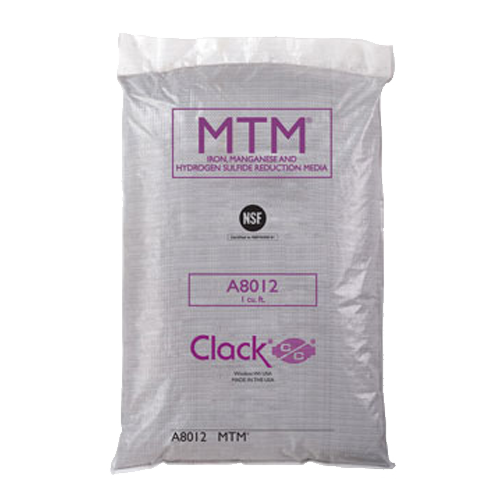MTM® is used for reducing iron, maganese and hydrogen sulfide from water supplies.
DESCRIPTION
MTM® is a granular manganese dioxide filtering media used for reducing iron, manganese and hydrogen sulfide from water. Its active surface coating oxidizes and precipitates soluble iron and manganese. Hydrogen sulfide is oxidized to a sulfur. The precipitates are filtered out in the granular bed and removed by backwashing.
MTM® consists of a light weight granular core with a coating of manganese dioxide. The coating provides an example of contact filtration where the media itself provides the oxidizing potential. This allows for a much broader range of operation than many other iron removal medias. A pH level as low as 6.2 can be treated. Dissolved oxygen is not essential. The media’s light weight reduces backwash water requirements.
When the oxidizing power of MTM(r) is reduced, the bed has to be regenerated with a weak solution of potassium permanganate (KmnO4), thus restoring its oxidizing capacity. A regenerating solution of 1112 to 2 ounces (dry weight) of potassium permanganate per cubic foot is sufficient for normal regeneration. Upon start-up a new bed should be backwashed and caution taken to insure that the lightweight media is not backwashed to drain. A new bed should be regenerated the evening of installation. Operating the filter after its oxidizing capacity is exhausted will reduce its service life and may cause staining.
MTM® requires either intermittent or continuous regeneration to maintain its oxidizing capacity. A solution of potassium permanganate (or chlorine then potassium permanganate) can be pre-fed to maintain capacity. In the latter case, he manganese dioxide coating acts as a catalyst to enhance the oxidation reaction and as a buffer to reduce any excess potassium permanganate concentration and prevent it from entering the service lines.
(back to top)
ADVANTAGES
Broad operating range for iron reduction
Lower pressure loss through the bed with high flock holding capacity
Effective hydrogen sulfide, iron and manganese reduction
Light weight requires lower backwash rates and reduces pumping requirements
Chlorine can be beneficial in extending filter run times
Low attrition loss for long bed life
Lower shipping cost
(back to top)
PHYSICAL PROPERTIES
Color: Dark brown
Bulk Density: 27 lbs./cu. ft.
Specific Gravity: 1.7 gm/cc
Effective Size: 0.6-0.7 mm
Uniformity Coefficienty: 1.9
Mesh Size: 12 x 35
(back to top)
CONDITIONS FOR OPERATION
Water pH range: 6.2-8.5
Maximum water temp: 100°F/38°C
Bed depth: 24-36 in.
Freeboard: 50% of bed depth (min.)
Service flow rate: 3-5 gpm/sq. ft. continuous
Backwash flow rate: 8-10 gpm per sq. ft.
Backwash expansion rate: 20-40% of bed depth (min.)
Regenerant dosage: 1 ½-2 oz. of KMnO4 by weight per cu. ft.
(back to top)
INFLUENT LIMITATIONS
Oil: None
Polyphosphates: None
(back to top)
CAPACITY PER CU. FT.
Iron (Fe+2) alone
600 grains (10,000 ppm)
Manganese (Mn+2) alone
300 grains (5,000 ppm)
Hydrogen Sulfide (H2S) alone
175 grains (3,000 ppm)
(back to top)
FLOW RATE
Service Flow Pressure Drop and Backwash Bed Expansion charts to be added later. Check back for updates.
(back to top)
ORDER INFORMATION
Part No. A8012
Description: MTM®
Cu.Ft./Bag: . 1
Wt./Cu.Ft.*: 27 lbs.
Bags/Pallet: 40
Weight/Pallet: 1130 lbs.
Pallet Dim. 48″x42″x40″
(back to top)
STANDARDS
Tested and listed under ANSI/NSF Standard 61 for Health Effects.
Drinking Water Treatment System Components Classified by Underwriters Laboratories Inc.® in Accordance with Standard ANSI/NSF 61-(1991)-57Y3.
(back to top)

